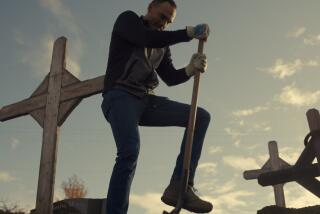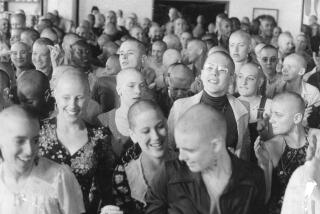Making sense of Jonestown
- Share via
Why did they do it?
In the nearly 30 years since more than 900 people died in what’s been called the largest mass suicide-murder in history, the question of why so many otherwise seemingly rational human beings could be persuaded to drink cyanide-laced Kool-Aid in the jungles of Guyana has been one of the most haunting of our time.
The riveting documentary “Jonestown: The Life and Death of Peoples Temple” comes as close as we are going to get to answering that question. Directed by the veteran Stanley Nelson (“The Murder of Emmett Till”), this calm and thorough film has just the right attitude and tone to deal with a most incendiary story.
Nelson and his team have done a considerable amount of work, tracking down numerous former temple members as well as the event’s few survivors and getting everyone to talk on camera. The result is harrowing stuff, with one man breaking down as he describes what it was like to have his wife die in his arms.
Also very much to the film’s advantage is how thoughtful and articulate these people are, both about why they joined the temple as well as the awful aftermath, making it clear that what they signed onto was not what the temple became.
“Nobody joins a cult, nobody joins something they think is going to hurt them,” one person says, and Jones’ adopted son and namesake adds, “Everything I tell you about Jim Jones is a paradox -- having this vision to change the world but having this whole undercurrent of dysfunction.”
Any discussion of Peoples Temple comes back inevitably to Jim Jones, the man in charge and the namesake of the colony in Guyana that was envisioned as a kind of utopia.
By joining the revivalist spirit of old-time Pentacostal worship (“This was a black church led by a white minister,” someone says) to a progressive social agenda, Jones created a powerful lure for people who wanted to do good in the world, who wanted a purpose in life bigger than themselves.
Intent on showing how Jim Jones became who he became, “Jonestown” investigates his Indiana boyhood growing up poor as the son of an alcoholic father, “obsessed with religion,” a friend remembers, “obsessed with death.”
Jones discovered his gift for preaching early on and was color-blind about racial issues as far back as anyone can remember. When he adopted Jim Jones Jr., it was the first time in Indiana history that an African American child had been adopted by a white family.
With his utopian, communal ideals -- he encouraged members to contribute their property in exchange for comprehensive care -- Jones was a natural fit for California, and he moved his ever-expanding church first to Ukiah in 1965 and then to San Francisco in 1974.
As Jones and his organization became more and more politically powerful, things changed. Though photographs show a man who never looked balanced, Jones’ drug use, his sexual adventures and his paranoia grew in size.
It is indicative of the depth of the human need to believe and belong that no matter what his excesses, members of Jones’ congregation continued to cut him the necessary slack.
An investigative story in New West magazine about Peoples Temple excesses caused Jones to flee to the settlement he had previously started in Guyana. Always supersensitive about treating people’s departure from the church as a personal betrayal, Jones was tipped over the edge when a visit by Rep. Leo Ryan encouraged several people to want to leave.
One of the most chilling aspects of “Jonestown” is its use of the audio tapes of Jones speaking on Nov. 18, 1978, encouraging, persuading, even insisting that people lay down their lives as “an act of revolutionary suicide protesting the conditions of an inhuman world.” He tells his congregation that “if we can’t live in peace, let’s die in peace,” repeating again and again, “quickly, quickly, quickly.” It’s even more chilling than it sounds.
Getting individuals to do this was not the work of a day or even a year. People had gotten in too deep to escape, had gotten into the habit of, as one man says, “letting Jim Jones think for me. He had a better plan.” Says one of the survivors, “I never use the word ‘suicide.’ That man was killing us.”
*
‘Jonestown: The Life and Death of Peoples Temple’
MPAA rating: Unrated.
A Firelight Media release. Director Stanley Nelson. Writers Noland Walker, Marcia Smith. Story by Smith. Director of photography Michael Chin. Editor Lewis Erskin. Running time: 1 hour 25 minutes.
Exclusively at Landmark’s NuArt, 11272 Santa Monica Blvd., West L.A. (310) 281-8223.
Nelson is scheduled to appear at 7:30 and 9: 45 p.m. shows Friday, and at the 5:15, 7:30 and 9:45 p.m. shows on Saturday.
More to Read
Only good movies
Get the Indie Focus newsletter, Mark Olsen's weekly guide to the world of cinema.
You may occasionally receive promotional content from the Los Angeles Times.











